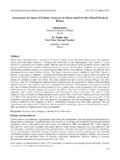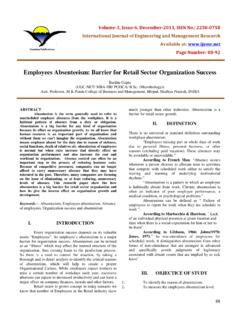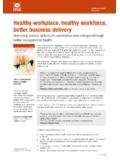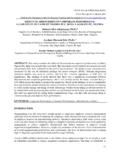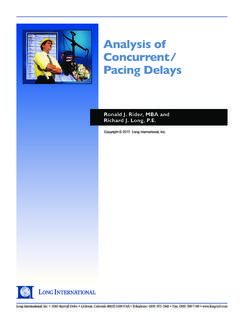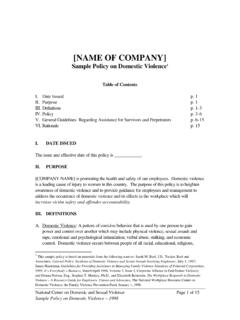Transcription of WHO march 2007 JP BRUN - World Health Organization
1 1 JEAN-PIERRE BRUNPROFESSORDIRECTOR CHAIR ON OCCUPATIONAL Health AND SAFETY MANAGEMENTWEB: stress : scientific evidence-base of risk factors, prevention and costsWork-related stress : scientific evidence-base of risk factors, prevention and costsWEB: cost : 42 billions USD(Kalia, 2002)USA150 billions USD for entreprises (Property and Casualty Insurance, 2002)Annual cost for mental Health problem : Stress cost : 300 billions USD for entreprises(absent isme, turn-over, baisse de productivit ) (Institut Am ricain du Stress, 2006)0,3 % of GDP2,6 % of GDP1,3 % of GDP2 WEB: Job strain : 177 millions in Sweden125 millions in DanemarkStress Cost :180 millions of days lostplus de 11 billions d (for entreprises)(1992)(1992)0,07 % of GDP0,7 % of GDPIn EuropeStress cost : 2,9 billions for economics cost6,6 billions for human costStress Cost: 20 billions for 60% of all sickdays(1999)(1999)0,27 % of GDP1 % 3,3 % of GDPWEB: IN ABC average of dayslost per employee, for a total of 67,923 daysThe lost days represent289 full-time jobs annuallyDirect costs of short-term sick leave are:$13,965,691 Indirect costs are estimated to be: $13,965,691 (ratio 1.)
2 1)Around 35% of cases are associated with mental healthproblemsDirect and indirect costs associated with mental healthproblems are thus approximately $ million3 ABSENT AND WORKED SICK DAYS BASED ON LEVEL OF PSYCHOLOGIQCAL DISTRESS sick daysWorked sick daysLow distressHigh distressMain Organizational Changes Increase in shift work (22%), night (18%) and weekend work (25%) Increase in part-time work (16%) and overtime (20%) Working very fast 55% (1977) to 68% (1997) (Theorell 1999) Never having enough time to finish work 40% (1977) to 60% (1997) (Theorell 1999) General intensification of work (fast pace, short delays, constant changes)4 Organizational Risk Factors9 Demands relating to tasks and roles9 Degree of involvement in decision making9 Employee recognition9 Decision-making autonomy9 Relationships9 Environment and physical working conditions 9 Work schedulesWEB: EVIDENCE Greatdecision-making powerreducesrates of absences and turnover(Bond and Bunce, 2001; Bond, Griffin, 1991; Wahlstedt and Edling, 1997).
3 Decision-making powerincreases level of performanceand job satisfactionand reducesfinancial losses(Bond and Bunce, 2001; McFadden and Demetriou,1993; Wall et al., 1992).5 WEB: EVIDENCE Lack of decision-making latitude andrecognitionincreases the risk of cardio-vascular diseases(Karasek, 1990, Marmot et al., 1997, Siegrist, 1996) A clearly defined roledecreasesabsenteeism and lateness(Kammeyer-Mueller and Wanberg, 2003).WEB: EVIDENCE Lowworkplace supportincreases the rate of absence(Melchior et al., 2003; Niedhammeret al., 1998; Northet al., 1996; Vahteraet al., 2000). High support at workdecreases the intentions to quit job(Brough and Frame, 2004; Houkeset al.)
4 , 2003; Rhoades et Eisenberger, 2002)6 WEB: EVIDENCE Abusive supervision is associated withan increase in absenteeism (Tepperet al., 2001). High presence of interpersonalconflictswithin a work team isassociated with a reduction in performance(De Dreu and Weingart, 2003).WEB: EVIDENCE The manager-subordinate relationshipis the mostcommonly reported cause of stress( Tepper, 2000; Curphy and Hogan, 1994) Manager behaviourcan have a significant impact on Health outcomes of subordinates( Gilbreathand Benson, 2004; Offermann and Hellmann, 1996) 7 WEB: BEST EMPLOYERS 2006 (Source: Hewitt)Profit sharingEdward Jones Canada10 Career planningEnvisionFinancial9 Skills profilesPCL Construction8 Leave for volunteeringMicrosoft Canada7 Culture of respect and trustBennett Jones6 Job sharingBC Biomedical5 Employee recognition programG&K Services Canada4 Autonomy and internalpromotion EllisDon for participation in decisionWellington West Capital2 Annual employeeevaluationCintas Canada1 Low decision-making powerLow use of skillsRole ambiguityPoor relations with co-workersCareer opportunitiesCompetitive climateLow recognitionWork-family conflictPressure linked to impact of decisionsRole conflictInsufficient and
5 UnclearinformationLow participation in decisionsPoor relations with supervisorQuantitative overloadDIFFERENCES BETWEEN T1 AND T2 (18 MONTHS) IN HIGH PSYCHOLOGICAL DISTRESS 38,944,432,947,436,238,336,644,536,844,3 0 20406080100 Percentage of high psychological distressRegistrarLibraryControlClericalA verageTime 1 Time 2 Significantdrop of distressSample: ONLY respondEnts at T1 ANDT28 RETURN ON INVESTMENT IN 18 MONTHSWORKFORCE: 111 new employees (+3%)PSYCHOLOGICAL SICK LEAVE: 191 cases (2003)165 cases (2004)SICK DAYS: 8515 days (2003)6132 days (2004)INSURANCE COST : $100,000 in one year( million total costs)(-14%)WEB: ACTIONE stablishing that the Health of people is a corporatebusiness decision criterion(ISO standards, management values)9 WEB: : , F.
6 W., Bunce, D. (2001). Job control mediates change in a work reorganizationintervention for stress reduction. Journal of Occupational Health Psychology, 6, , P., & Frame, R. (2004). Predicting police job satisfaction and turnover intentions: The role of social support and police organisational variables. New Zealand Journal of Psychology, 33, Dreu, C. K. W., & Weingart, L. R. (2003). Task versus relationship conflict, team performance, and team member satisfaction: A meta-analysis. Journal of AppliedPsychology, 88, , I., Janssen, P. P. M., de Jonge, J., & Bakker, A. B. (2003). Specific determinants of intrinsic work motivation, emotional exhaustion and turnover intention: A multisamplelongitudinal study.
7 Journal of Occupational and Organizational Psychology, 76, , J. D., & Wanberg, C. R. (2003). Unwrapping the organizational entry process: Disentangling multiple antecedents and their pathways to adjustment. Journal of Applied Psychology, 88, , R. A. (1979). Job demands, job decision latitude, and mental strain: Implications for job redesign. Administrative Science Quarterly, 24, , M., & Demetriou, E. (1993). The role of immediate work environment factors in the turnover process: A systematic intervention. Applied Psychology: An International Review, 42, , M., Niedhammer, I., Berkman, L. F., & Goldberg, M. (2003). Do psychosocial work factors and social relations exert independent effects on sickness absence?
8 A six year prospective study of the GAZEL cohort. Journal of Epidemiology and CommunityHealth, 57, : , I., Bugel, I., Goldberg, M., Leclerc, A., & Gueguen, A. (1998). Psychosocial factors at work and sickness absence in the Gazel cohort: A prospective study. Occupational and Environmental Medicine, 55, , F. M., Syme, S. L., Feeney, A., Shipley, M., & Marmot, M. (1996). Psychosocial work environment and sickness absence among British civil servants: The Whitehall II study. American Journal of Public Health , 86, , L., & Eisenberger, R. (2002). Perceived organizational support: A review of the literature. Journal of Applied Psychology, 87, 698-714.
9 35 Tepper, B. J., Duffy, M. K., & Shaw, J. D. (2001). Personality moderators of the relationshipbetween abusive supervision and subordinates resistance. Journal of AppliedPsychology, 86, , J., Kivim ki, M., Pentti, J., Theorell, T. (2000). Effect of change in the psychosocial work environment on sickness absence: A seven year follow up of initiallyhealthy employees. Journal of Epidemiology and Community Health , 54, , K. G. I., & Edling, C. (1997). Organizational changes at a postal sorting terminal their effects upon work satisfaction, psychosomatic complaints and sick leave. Workand Stress, 11, , T. D., Jackson, P.
10 R., & Davids, K. (1992). Operator work design and robotics system performance: A serendipitous field study. Journal of Applied Psychology, 77, , R. A., & Theorell, T. (1990). Healthy work: stress, productivity and the reconstruction of working York: Basic , J. (1996). Adverse Health effects of high-effort/low-reward of Occupational Health Psychology, 1, 27-41.











